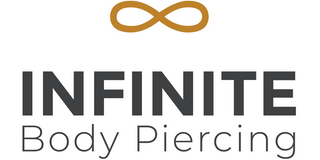Adverse Reactions and Infections
Skin reactions and irritations can occur anytime, regardless of what type of jewelry you use or the length of time you wait between stretches. While some materials are undoubtedly more reactive than others, everyone is unique; what works for someone else may not work for you. Changes in your health, environment, and lifestyle can affect your body’s tolerance to foreign materials, but as long as you keep an eye on your piercings, you should quickly realize what works.
Generally, healed piercings are more forgiving than healing piercings. While initial piercings should be done with jewelry that is truly biocompatible, healed ear piercings often allow for more exotic materials: horn, bone, wood, stone, amber, bamboo, etc. While buying jewelry from a reputable vendor will usually mean these materials should be trouble-free for stretched piercings, everyone is different, and there is always the chance—however small—that you will have an adverse reaction to jewelry made from natural (organic) materials.
If, especially after recently changing to new jewelry, you suddenly begin to get itching, swelling, a rash, redness, or clear fluid discharge, you may be having a reaction to what you’re wearing. Take your jewelry out, put in something less reactive (like implant-grade steel, titanium, or glass), and resume daily salt-water soaks until the irritation has cleared up. (See our aftercare for more info.)
Keep in mind: your jewelry might not be the cause of your reaction. If you have started cleaning the area with harsh, synthetic soaps or solutions, you could be having a reaction to your cleaner and not your jewelry. If you suspect a cleaning-solution reaction, stick with salt-water soaks and/or saline rinses, and pay attention to your body and your body’s reactions.
Unlike reactions, infections are caused by bacteria, and they can occur any time there is a break in the skin. Since stretching often results in minor tears and fissures, this means that every time you stretch you are at risk of an infection, even though the risk is usually minimal. If you notice such issues as extreme swelling, pain, redness, a greenish or yellow discharge with an odor, itching, and/or the piercing is hot to the touch, you may actually have an infection and not a reaction. Since infections can be serious, you should consult your doctor as soon as possible, as additional treatment may be necessary.
Blowouts
Blowouts are an uneven distribution of skin and are the direct result of stretching too far, too fast. A blowout occurs when the pressure on the stretched skin becomes too great and, as a result, a lip of skin bulges out. In extreme cases, your piercing may actually look as though it has been turned inside-out. (There’s a reason it’s often called “cat butt;” it’s not attractive.) If a blowout occurs, the most important thing is to downsize your jewelry immediately; sea-salt soaks and massaging the area will help break down scar tissue, but keep in mind you may still end up with permanent scarring. Once the area has healed, start your next stretch from the other side, “tucking in” the excess tissue. And if you do tear or blow out your holes, take it as a reminder to stretch more slowly next time.
The only 100% effective treatment for blowouts is not to stretch too quickly in the first place. Blowout damage is not easy to repair, and is more often than not permanent. Be patient!
Wet Ear
While uncommon, stretching with non-porous materials (typically glass) can occasionally result in a condition some piercers refer to as “wet ear.” This is where the skin in contact with the jewelry secretes too much fluid, creating a sticky, moist, “sweaty” layer between the ear and the jewelry. Left untreated, the moist environment can make the skin more susceptible to infection. Temporarily replacing the non-porous plugs with jewelry of another material, combined with gentle cleaning, is usually enough to get things back to normal within a few days.
If you are particularly prone to getting wet ear, be sure to keep your piercings dry, especially if you shower with your plugs in, and wipe off your jewelry regularly in hot, humid weather.
Rips and Tears
Like blowouts, tears and rips are often caused by stretching too fast. If your skin tears during a stretch you will usually know immediately. You will often get some bleeding, and the jewelry that was so hard to push through a moment ago will suddenly slide right in. If this happens, downsize and soak the piercing in warm salt water at least once daily. Once it is no longer scabbing or crusty, add oil massages to your daily regimen. This will speed healing and soften any developing scar tissue.
Thinned Lobes
The skin surrounding any piercing can thin when stretched, but due to the size and surface area involved, thinned earlobes are particularly common. Lobes can thin out due to over-stretching, stretching too fast, or an initial piercing placement which was too low. One of the best ways to thicken lobes is to downsize and allow the skin to regain a better blood flow, and grow more skin cells, before slowly, and carefully, stretching back up. Oil massages are also particularly useful, as the act of massaging encourages blood flow to the area.
However, in some cases, the thinned skin is no longer able to support jewelry. If the thinner part of your earlobe becomes paler and cooler to the touch than the surrounding area, this may be a sign that blood flow is compromised. In extreme cases you may see tissue start to slough off and the color change from darker red to purple—or even black if the tissue becomes necrotic. In these cases, jewelry should be removed before the tissue breaks. Once that happens, you’re outside of the expertise of most piercers; you’ll need to be talking to a plastic surgeon.
